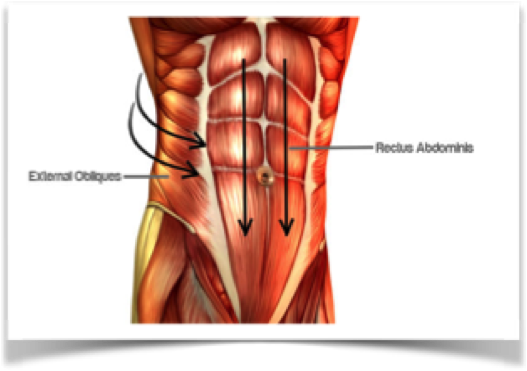I get asked a lot why it’s important to engage your core while working out, so I felt it was time to write a post about it.
Diving right into it, your core muscles are the foundation of all movement, so it’s important that you master intersegmental stabilization—which really just means the ability to co-contract your deeper core muscles at the right time with the appropriate amount of tension.
How do you properly engage your core muscles?
There definitely is an art to this—and unfortunately there is not one method that works for everyone—but there are some common strategies that we use daily at BIM to help you keep your core effectively engaged.
The first step to keeping your core engaged is—not surprisingly—understanding what you are engaging.
Your deeper core complex includes:
- Your transversus abdominis
- Pelvic floor
- Diaphragm
- And your deep spinal stabilizers: multifidus, illicostalis, and longissimus
While your superficial core complex includes:
- Your internal obliques
- External obliques
- Rectus abdominis
- And your latissiusm dorsi (or lats)
To avoid boring you completely I am not going to go into detail about what each muscle does, and how each contributes to your overall core stability. I will however highlight the fact that your deeper core complex is often a group that a lot of people loose strength in, or simply stop engaging. Due to this it’s worth setting some time aside a few mornings a week—or before each workout—to do some low level core activations to ensure that you are able to recruit these muscle fibres effectively. Here’s how”
Step 1: Setting your spine to neutral
Establishing a neutral spine is important and may be different for everybody. Generally you know your spine is neutral when you’re in a position that your body feels most comfortable in, as you must be able to maintain this posture (comfortably) during different positions.
There are two components to establishing a neutral spine:
-
- Setting your pelvis
- Setting your rib position
At BIM we find the easiest way to find your neutral posture is either in a supine position or by lying on your back with your knees bent. So give that a try and see what feels right.
Step 2 – Set your pelvis to neutral
The best way to set your pelvis to neutral is to complete a few pelvic tilts, then go from an arch, (or anterior tilt) to about half way down—or just stop at what ever point feels the most comfortable for your spine. The video below will give you a better idea of what I mean by this.
Note: It’s important that you go from an arch to neutral, as doing so will help you to engage your deep abdominals properly.
Step 3 – Setting your ribs
The most effective why to set your ribs is to pull them down towards your belly button—check out the video below to see what I mean by this.
Rib depression can be tricky if you have thoracic mobility restrictions, a poor breathing pattern, or weak external obliques. At BIM we find the easiest way to learn how to do this movement properly is to blow up a balloon—sounds weird I know but just trust me with this one, it works.
If you are new to this concept, then practicing setting a neutral spine and rib position while breathing naturally—preferably diaphragmatically—in this posture might feel a bit difficult for you. But make sure that you master this before moving on. Once you have, you can then start to progress with some small movements.
Here are three that you should try:
Leg lifts with a dowel across hips
Side lying clamshells
4 point kneeling opposite hand knee lifts
When performing all of the above exercises you should feel a low level of activation. I believe it was Mike Robertson who used the analogy of comparing core engagement to a volume control that goes from level 1 to level 10. Whether you’re deadlifting 400 pounds or picking up a 80 pound suitcase you are going to need to use a strong brace—or as Mike would put it, turn the volume up to level 9-10.
However if you are doing an exercise that requires less effort and force production, such as a clamshell there is no need for such a strong brace. In fact you probably won’t ever feel any sort of fatigue in your lower abdominal region during these types of exercises. Instead all you are looking for is activation.
Often people will tell me that the exercise that I am having them do is “too easy” or that they “can’t feel anything.” If you’re finding the same thing when you’re working out this is actually a good thing, as it means that you’re effectively engaging the muscle grouping that you’re working out.
If an exercise or movement is “simple” or “easy” then you should be able to complete it correctly and feel your muscles engage quite easily. The problem is not the simplicity of the exercise; it’s actually the lack of connection with your deep core musculature and your inability to engage those muscles when necessary that’s the problem. I am confident that if you practice the above exercises for one week you will start to feel the right muscles engage, and understand what I am talking about.
That said, I encourage you to make a point of practicing some low level core activation exercises daily (or as part of you warm up) then take the principals of an effectively engaged core and apply them to your bigger movements and/or throughout the day. The more you practice the better you will get which will lead to increase muscle activation to the area and more efficient core timing and sequencing.
If you’d like personalized help toning/building your core, book a free fitness assessment with us to get started.









Extremely useful page and videos–just what I’ve been looking for. Thanks so much!